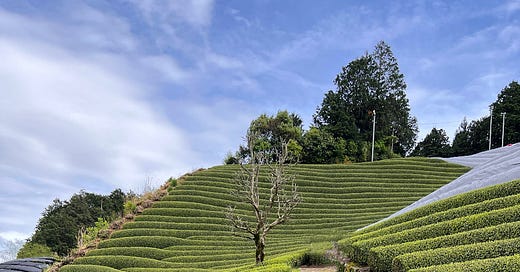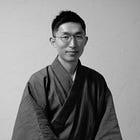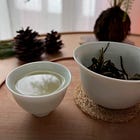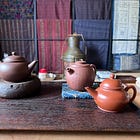May 21st is the International Tea Day. And I have been celebrating it everyday. Most days, I drink the same teas — yet they never taste exactly the same. My routine is Japanese matcha in the morning, Taiwanese Four Seasons oolong in the late morning, Chinese tea in the afternoon when I have time.
In Japan, I have been visiting historically significant tea sites from Hakata, Toganoo, to Uji. Of these, Uji has brought me closest to the tea leaves. This month, I have been harvesting tea (茶摘み chatsumi) in Uji once or twice a week, for five hours each time, with a fifth-generation tea producer family. I am lucky that the first tea cultivar that I learned to handpick is the Asahi cultivar, one of the highest grade for producing gyokuro and tencha (to be grounded into matcha).
Today, I will continue to be in the tea field to handpick the Samidori cultivar with other obachans. Old ladies who don’t understand English and a good immersion for me to practice Nihongo. With our inability to communicate, I just get the space to focus on handpicking only young tea leaves from the sea of green.
Tea harvesting has become my moving meditation.
What’s the difference between Japanese and Chinese teas?
This long post is inspired by a question from
, Writer of Teacup of Tao.All four of my grandparents fled China to Malaysia during the Sino-Japanese War. Now I live in Kyoto, married to a Japanese. It makes me wonder how China and Japan have become so politically distant, despite being economically interdependent with deep cultural similarities back to the ancient times, as early as the 5th century (So, I’d also like to trace their common threads).
This post is informed by my current interpretations based on what I’ve learned so far since early last year from books, tea teachers and practitioners — Dairik Amae, Vivian Zhang, Naoko Iwasaki, 隠雲京都, Pau Valverde Molina (Writer of Raw, Grilled, Boiled) — as well as from exchanges with
(Writer of Taoism Reimagined) and (Writer of Shitsurae Japan).Tea types and social-cultural context
Spiritual and philosophical foundations
Seasons, Yin-Yang, and the 5 elements
Aging and time
Curiosity isn’t random. It’s a compass. — Shane Parrish, Founder of Farnam StreetTea types and social-cultural context
At the surface level, tea categorization is based on the 1979 classification by Professor Chen Chuan, a respected Chinese tea scholar.
The 6 tea types based on processing from low to high oxidation level are: White tea, green tea, yellow tea, oolong tea, black tea, dark tea including Pu’er. Black tea is called ‘RED’ tea in Japanese and Chinese (and there’s a colonial story behind this). Flower teas are not part of the six categories but I do like them! There are also non-caffeinated teas.
Japanese Chadō primarily uses matcha (green tea in powdered form). Following the initial introduction of tea from the Tang Dynasty in China and with a more direct influence during the Song Dynasty, Chadō was further refined and developed in Japan — from monks for medicinal use to the samurai warrior class viewing tea as a highly ritualized spiritual and artistic pathway. Zen Monk Eisai’s Drink Tea and Prolong Your Life (Kissa yojo ki) is considered the foundational tea text in Japan.
There is also Japanese Senchado, developed later during the Edo period after the introduction of Chinese Ming Dynasty’s steeped tea methods. Senchado uses sencha (steeped green tea from leaves) instead of matcha powder. Its form tends to be more relaxed than ritualized, as it was embraced by the cultured literati class and their 文人 ideals of personal refinement and elegant simplicity. Zen Monk Baisao (also a poet) rebelled against the formalized, ritualistic practices of Chadō matcha tea culture of his time by introducing sencha.
Japanese teas are typically associated with green teas but Japanese black teas 和紅茶 and Japanese oolong teas are becoming increasingly common, often produced in niche small batches.
Chinese tea was predominantly green until the Ming Dynasty Emperor Zhu Yuan Zhang’s ban on imperial tribute system of pressed (green) tea cakes. His ban freed tea artisans to experiment with more diverse tea processing methods. The result? From one ancient camellia sinensis (Chinese camellia) leaf, we get the 6 tea types we now know and enjoy.
Chinese tea with its longstanding history stretches as far back as pre-Tang Dynasty with the legendary Cha Nong, viewing tea as medicine. The Classic of Tea by Tang Dynasty scholar Lu Yu is the foundational text in Chinese tea culture.
Both Tang and Song Dynasties are considered golden ages of Chinese tea culture and poetry with many famous poets - some of whom were political or government officials - writing about tea as a key part of their daily life.
Tea in China has undergone multiple transformation through three major preparation styles of 唐煮, 宋点, 明泡 — 1) Cooked tea with compressed tea cakes (Tang Dynasty and earlier), 2) Whisked tea with powdered green tea like today’s matcha (Song Dynasty), 3) Steeped tea with loose leaves (Ming Dynasty onwards).
Currently, there are multiple brewing styles, from 1) Gaiwan 盖碗 style introduced during the Ming Dynasty with porcelain lidded bowl, traditionally with a saucer, 2) Small clay teapot 茶壶 style with Yixing or chaozhou clay, to 3) Chaozhou gong fu cha 潮州工夫茶 with multiple infusions. Teas commonly used for gong fu cha tend to be moderately to fully oxidized: Oolong, Pu’er dark tea, black tea 红茶.
Taiwanese tea is similar to Chinese tea but Taiwanese tea culture tends to favor smaller teapots over gaiwan. Typically, Taiwanese teas tend to favor floral, buttery, and sweet aroma expressed through their own cultivated oolong teas, including high mountain oolongs, sun moon lake black teas, to the lightly oxidized baozhong teas.
Spiritual and philosophical foundations
In the way of tea 茶道, the underpinning spiritual foundation is the same between Japanese and Chinese and Taiwanese tea cultures.
The differences arise from their practices.
Cha Dao 茶道 in Chinese and Taiwanese tea focuses more on the first character - 茶 tea. Tea leaves are at the heart of practice for Chinese and Taiwanese Cha Dao. From leaf-to-water ratio, water temperature, and brewing time, to choosing quality tea leaves, selecting the right tea wares, using quality water, and appreciating taste and aroma — a full spectrum of sensorial refinement. Mastering these brewing techniques takes time and patience, as each of the 6 tea type is sensitive and requires careful understanding.
Over the years, Chinese and Taiwanese tea traditions have been shaped by Taoism, Classical Confucianism, Ch’an Buddhism, Neo-Confucianism (during Song and Ming Dynasties as a Confucian response to Taoism and Buddhism), and the scholar-literati cultural-aesthetic practices.
Taoism is most prominently reflected in the spirit of Cha Dao with tea as a way of harmonizing humanity with nature 天人合一. It emphasizes key Taoist concepts from Laozi and Zhuangzi — click below links for interpretations by :
Wu-wei 無為 (effortless action aligning with nature)
Ziran 自然 (naturalness or spontaneity)
Xiaoyao 逍遙 (carefree wandering)
In essence, aligning with the Dao 道 for a return to the simple, the flowing, and free.
Japanese Chadō focuses more on the second character - 道 Dao or the way. 和敬清寂 Wa-kei-sei-jaku is at the heart of practice for Japanese Chadō. It places greater weight on the space of the tearoom, the ritual, the aesthetics, the host-guest relationship, the temae movements 点前 or ritualized tea preparations, and the spiritual experience of the tea gathering as a form of moving meditation.
Japanese Chadō, like Chinese and Taiwanese tea traditions, has been influenced by Taoism, Classical Confucianism, Ch’an Buddhism (evolved into Zen in Japan) along with Neo-Confucianism and Shintoism (both asserting greater influences during the Edo period among the samurai class).
Their influences are expressed through the spirit of wa-kei-sei-jaku — see Dairik Amae’s video podcast.
Wa (Harmony in Taoism)
Kei (Respect in Confucianism)
Sei (Purity in Shintoism)
Jaku (Tranquility in Zen Buddhism). Think of the minimalist, subdued aesthetics in a Japanese tearoom.
In modern Chadō, all the above-mentioned philosophical influences are present in the tearoom, with Zen Buddhism being the most prominent, followed by Confucianism. However, the emphasis ultimately depends on the host’s intentions.
Seasons, Yin-Yang, and the 5 elements
In Chinese and Taiwanese tea traditions, seasonal shifts are reflected in the tea itself - with complementary pairing of cooler teas like green or white teas for warmer days; warmer teas such as medium to heavily roasted oolongs, black, dark teas for cooler days.
In contrast, Japanese Chadō observes seasonal changes in the space of the tearoom, through elements like flower arrangements, calligraphy scrolls, sweets, and the ‘kama’ kettle placement.
Japanese and Chinese and Taiwanese teas are all deeply rooted in the philosophy of the I-Ching 易经 with deep connections to both Taoism and Confucianism:
Change is constant. Nothing is static given the ever-changing nature of life. Everything is in constant motion, flowing and changing.
Balancing Yin-Yang and the 5 elements. I-Ching is built on the interaction of yin and yang — opposite yet complementary forces of cool and hot elements. In tea (as in nature and the seasons), balance shows up through the five core elements of wood, fire, earth, metal, water.
Harmony between nature and humanity. Harmony with nature starts with awareness. Each moment contains the seeds of the next, and every of our action leaves its traces. Through tea, we observe the patterns in nature and in life.
Observations in seasonal shifts reflect Taoist alignment with the rhythms of the universe.
The 5 elements are fundamental in the shaping of our natural world and the universe. They interact with the seasons - from the 24 solar terms and 72 micro-seasons, time in a day, to associations with teas.
The following is just a suggestion based on what I’ve learned from my Chinese and Taiwanese tea teachers (Note: Tea pairing depends on one’s body constitution and health condition — everything in moderation and drink what feels good to you):
木 Wood | Spring | From 3 am | New beginnings, upward energy, growth | Raw pu’er, green or white teas
火 Fire | Summer | Late morning to early afternoon | Peak energy, expansion, radiance | Light oolong, green or white teas
金 Metal | Autumn | Late afternoon to early evening | Clarity, refinement, letting go | Oolongs or aged white teas
水 Water | Winter | Late evening into midnight | Stillness, depth, introspection | Ripe pu’er, black teas
土 Earth | 4 seasonal transitions especially late Summer | Grounding and stability | Mellow aged teas, Pu’er, Liu Bao, Heicha
Aging and time
Teas, like people, become more fascinating with age. Time draws out their depth and deepens their complexity - often through hardship that first flattens, then refines them. Intriguing qualities are not constant; they evolve over time, much like the shape of an 'M', with dips in between, before true richness is revealed.Japanese teas can be aged but less common than Chinese and Taiwanese teas. And the types of Chinese and Taiwanese teas that can be aged are:
White teas (especially Bai Mu Dan, Shou Mei, Moonlight White)
Oolong teas (especially Wuyi rock teas, aged Tieguanyin, Chaozhou Dancong)
Pu’er (Raw and ripe) - Dark tea family
Liu Bao - Dark tea family
Heicha (Hunan, Sichuan, Yunnan) - Dark tea family
Generally, teas that do not age well are the fresher, lighter ones such as green teas, light white teas (Silver Needle), Un-roasted floral oolongs (fresh Tieguanyin and Baozhong).
In the teapot lies another world
The world of tea is incredibly vast. One of the most fundamental element to tea appreciation is to keep an open and humble mind while withholding quick judgment.
Inside the teapot lies another world, where time runs slower and the sun and moon linger. Within the world of tea is a quiet realm, a place of tranquility and peace, stretching beyond the reach of the everyday.
I have written a lot about tea but still can’t quite put into words this enchanting pull tea has on me — can you? 🌱🫖












Sencha is SUCH an interesting case.
Baisao bragged that he got his tea from china:
I love the idle solitude
Of slow September days
Fragrance from a stoneware brazier
Rising in shade of a thousand pines.
No sweltering worldly heat
Could ever reach me here
No marvel in the sages realm
Can tempt me from it either.
My water is dipped from
The pure otawa springs
My tea is grown in China
(I have it sent from home)
Life's ultimate pleasure
Is to be free from care
Yet people point and snigger
'Crazy old tea-grubber.'
And, as I understand it, many who began practicing sencha took it as an opportunity to emulate chinese Literati. And then senchado represented a sort of synthesis!
I love this! Thank you!
Trying to answer the question… I find it fascinating that one leaf managed to cultivate this entire cosmos. Wherever tea is taken seriously, it expands into the delicacy of life and nature. Tea cultivates not only a precise relationship to the leaf, but asks us to place everything from pot to cup to room… with intention.
The different understandings of Chado and Chadao got me thinking, but still, tea is a powerful and yet so simple way for cultivation, without dogma.